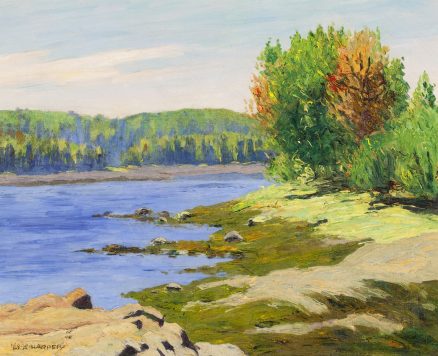- Categories
- African American artists
- Landscapes
- Zoom in on Artwork
- Print Page
- Email Page to Friend
William A. Harper’s sketch-like landscape shows a deserted scene of a riverbank with trees, some bearing the russet leaves of early autumn. The vivid colors in this work include rich blues, not only in the flowing water and the sky but tinting the dense woods on the far shore. Distinct brushstrokes are evident, particularly in the trees on the right; in the foreground, more blended paint indicates succeeding bands of muddy bank, rock, and dry soil. Harper seems to have been less concerned with conveying the surface qualities of the landscape’s features than with exploring relative tonal and color values and the juxtaposition of near and distant elements in the landscape.
From the beginning of his brief career, Harper focused on landscape painting. He found his subjects in a variety of locales, notably Cornwall, England, and rural France, which he interpreted in a romantic manner that reveals the influence of the French Barbizon school and of his most important landscape teacher, Charles Francis Browne. This painting, however, manifests a fresh immediacy, strong color, and rapid brushwork that, combined with the absence of any human presence, suggests an American setting. It may depict the area around Eagle’s Nest, an exclusive summer art colony overlooking the Rock River at Oregon, Illinois. Harper’s mentor Browne was a founding member of the colony and an avid painter of the surrounding scenery. Possibly thanks to him, by 1905 Harper had already spent several summers at Eagle’s Nest as an “assistant” to the artists. There he also found time to paint works “that commanded our genuine admiration and respect,” according to an unnamed colony artist writing after Harper’s death.i
Harper’s memorial exhibition at the Art Institute of Chicago in 1910 included two works, The Stream and The River Bank, either of which might have been this landscape. Never previously exhibited, according to existing records, these paintings may have been among several relatively minor or student works included in the memorial show, which was intended to liquidate the artist’s estate. All the exhibited paintings were for sale, perhaps to benefit Harper’s father and brother, who were living in Decatur, Illinois, at the time. In this work, the signature at lower left, in which a faint “Harper” was reinforced with a more distinctly painted “W. A. Harper,” perhaps indicates the artist’s transition from student to confident professional.
Wendy Greenhouse, PhD
Donated by M. Christine Schwartz to the Newberry Library, Chicago, Illinois, in 2021
i “The Whirl of Society,” Chicago Inter Ocean, Feb. 9, 1905.
